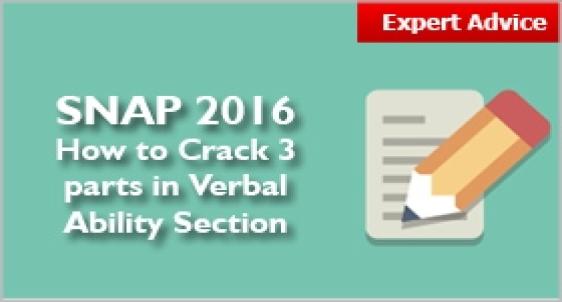
Verbal Ability in SNAP 2016 will consist of 3 parts namely Reading Comprehension passages, Core Verbal Ability and Verbal Reasoning. The section will have 40 questions in MCQ format and will carry a weightage of 40 marks out of maximum 150 marks.
SNAP 2016 is the gateway to various management programmes 2017-19 batch in 15 B schools affiliated to Symbiosis International University. The exam will be held on December 18, 2016 in single session. SNAP 2016 will be a paper pen mode Multiple Choice Questions based examination of 2 hours duration from 2PM to 4PM. Candidates are allowed with blue or black ball pen to the examination hall.
Candidates aspiring to join MBA 2017-19 programs offered by 15 institutes affiliated to Symbiosis International University have to take the common, mandatory Symbiosis National Aptitude (SNAP) 2016 Test. A candidate must register for SNAP Test & then register with the institutes offering his/ her choice of program by paying separate institution registration fees. If shortlisted, he/she would then attend the GE-PIWAT process conducted by these institutes
General English: Key component in SNAP 2016
In the revamped structure of SNAP 2016, the first section of General English comprising 40 questions on Reading Comprehension, Verbal Reasoning, Verbal Ability will play an important role with the high weightage of 27%. Earlier the highest weightage went to Analytical and Logical reasoning section which has now been brought down at par with General English and Quant sections.
In the forthcoming SNAP 2016 candidates will find 4 sections with 150 questions carrying a total maximum marks of 150. The marking system in SNAP 2016 will be as follows: Verbal Ability and Reading comprehension – 40 marks; General Knowledge and Current Affairs-30 marks; Quantitative Ability and Data Interpretation-40 marks; Analytical and logical Ability – 40 marks. Penalty of ¼ marks will be applicable for every wrong answer in SNAP 2016.
Although candidates are allowed to attempt any section in any order, sectional cut off will always be there. One has to score at least a minimum cut off score in each of the four sections.
VA RC: Fundamentals & Usage – key to success
Verbal Ability and Reading comprehension in SNAP 2016 shall have 40 questions of one mark each. Prof. S.K. Agarwal, expert on Verbal Ability, shares key preparation tips to improve score in Verbal Ability and Reading comprehension in next 90 days.
The Verbal Ability section in SNAP 2016 will have questions on English language usage, Reading Comprehension, Verbal Reasoning and Verbal Ability. SNAP like other important Management entrance examinations has the sectional cut off also. MBA aspirants, therefore have to score at least a minimum cut off score in each of the four sections.
Out of the 40 questions in Verbal Ability section there are about 6 questions on Reading comprehension and 6 to 8 questions on Error corrections. SNAP aspirants are required to have clarity of fundamentals, concepts and must know how to use them. Let us take each of the parts and know what to be studied in the area-
Error correction
Error correction in sentences is most of the time based to test your knowledge on usage of parts of speech, and other parts of English grammar. It is an important part of Verbal Ability section. There may be 6 to 8 questions on usage of tenses, phrasal verbs, syntax, passive voice, conditional sentences, reported speech, nouns, pronouns, adjectives, articles and more topics on English language. The questions may be framed to find out the correct/incorrect sentences, fill in the blanks or spot out the usage in different forms.
The topics cited above can be prepared in 30 days’ time, if proper schedule is maintained. There are certain similarities in different tenses. Half an hour a day is sufficient to all the indefinite, continuous and perfect tenses. All the other parts in grammar can be understood well in four five days.
Keep a good grammar book with you, practice specific exercises find out your errors and rectify them.
Examples
You may expect following type of questions in this section. Questions are not very tricky but need consistent practice with understanding of rules of English language.
Q.1 Thank you for helping me study. If you hadn’t tutored me I would fail the test.
A.Thank you for helping me study. If you hadn’t tutored me I would fail the test.
B.Thank you for helping me study. If you hadn’t tutored me, I would have failed the test.
C.Thank you for helping me study. If you haven’t tutored me, I would fail the test.
D.Thank you for helping me study. If you didn’t tutored me, I would have failed the test.
1.A 2.B 3.C 4.D
Q.2 They said that they______ coffee in the mornings.
- will drink
- shall take
- drink
- drank
Answers:
- 2.B- Past in the past – unreal past with improbable and impossible condition. Use of punctuation mark – Comma required.
- C) Typical use of Reported speech as it is based on regular habit and practice. It is also not a matter of past as they still do it. The sentences has the same expression as the sentence “They said that the Sun rises in the East”. Otherwise the sentence would be framed like “They said that they earlier/usually drank coffee in the mornings.” So put the verb of present tense.
Reading Comprehension: Expect 6 tricky questions
Reading Comprehension Passage in SNAP is not very difficult but you need a regular reading practice. If you understand the RC passage well, you can crack it accurately.
Types of questions are like tone of the passage, title of the passage, main idea of the passage, explaining the phrases and words and one or two questions on the information given in the passage.
Make it the regular practice to read the editorials, articles in the news paper and check how many words are there which you do not know. Tests have shown that the number of unfamiliar words in a passage, if exceeds about one in twenty, the reader will lose track. Use the words in conversation to practice more on them.
Write a summary in your own words neatly and precisely – with one third/fourth in length to the original length of the passage.Make a chart on time consumed in reading and writing the summary of the passage. Check whether the time is getting reduced after a day or two. Go for versatile reading with different topics. Try to mark and note down the interesting/important words or sentences.
Use complete sentences, Take care to understand, make a chart on time consumed in reading and writing the summary of the passage. Check whether the time is getting reduced after a day or two.
Analogy
A good vocabulary can help you crack the questions on Analogy. Relationship among words is not very difficult to find. There may be 3-4 questions on analogy asking you to identify the similarity or dissimilarity among the words. The key tips to prepare in this area are to improve the vocabulary to understand the meaning of the words.
Identify the exact relationship between the words/sentences. Check the pattern used. Form small and precise sentences to identify this relationship. You may find very close answer choices so be on your guard before opting for an answer.
There are certain words that have more than one meaning, so watch for such words like dear, sweet, train, watch, book, kind, or idiomatic/phrasal use of the words.
You may confront the words not familiar to you. In that case in case of a breakable word – split it-try to understand the roots and try to remember something related to the word. if possible frame a sentence using the word and check if it is negative or positive word – A-, an-, Un-, Im-, Dis-, anti-, Non-, Mal-, etc.
The need is to practice more. Most of the MBA aspirants seeking admission opportunity in 2017 will also appear in CAT 2016, IIFT 2016 and also plan to appear in XAT 2017. You can very well club your SNAP 2016 preparation with all the above exams. The only thing that is required is to practice more in accordance with SNAP 2016 exam pattern to get a high score.
Related Article
SNAP 2016: Revised pattern with reduced weight to Reasoning; still remains a major score booster
SNAP 2016: Reasoning and GK trimmed; Exam pattern overhauled; introduces uniform sectional marking
SNAP 2016: Registration process opens today; Paper based Exam on Dec 18 with no changes
SNAP 2016: Registration starts in August; know the exam schedule and pattern
SNAP 2016: Analytical & Logical Ability offers 33% weightage: Key tips to prepare and crack
SNAP 2016: Learn from past exams; your 4 months preparation strategy - expert guidance
SNAP 2016: All dates announced; no ups & downs in exam pattern - focus on preparation
SNAP 2016: Exam Notification release on Aug 21 confirmed; entrance test on Dec 18
Stay tuned to MBAUniverse.com for more updates and tips on SNAP 2016



























